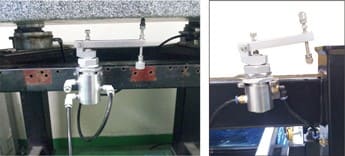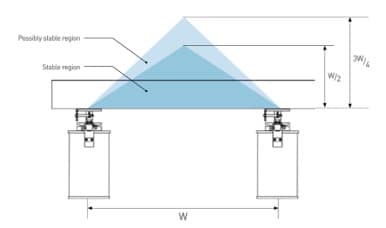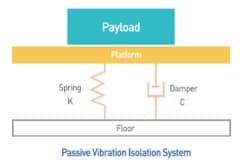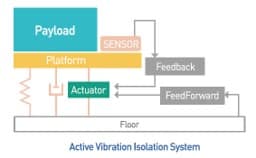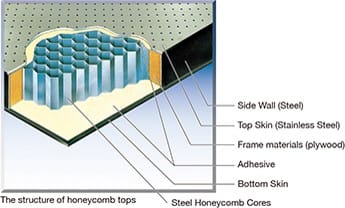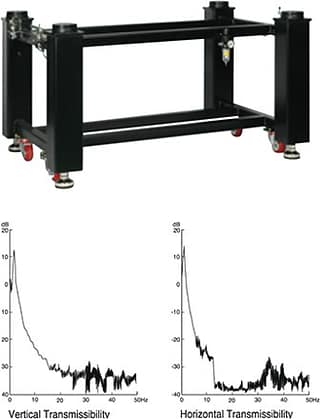Vibration Isolation Systems
Source of Vibration
There are three primary sources of vibration which can disturb a payload : a) Ground vibrations, b) Acoustic noises, c) Direct force disturbances.
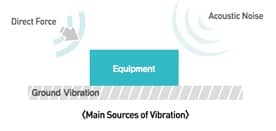
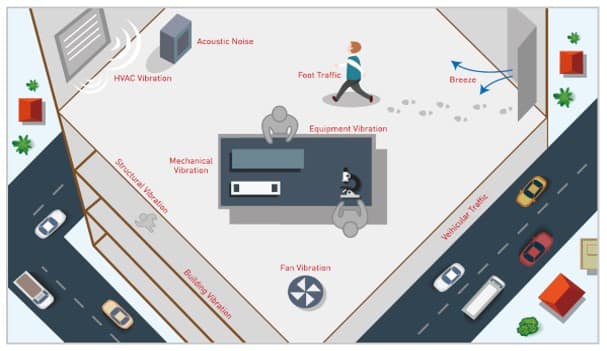
For example, even low-amplitude vibration can affect the performance and yield of lithography equipment such as stepper, the resolution of electron microscopes, the accuracy of measuring machines, and the performance of many types of precision equipment and instruments for electro-optical research. The cultural disturbances affecting the sensitive equipment is man-made and caused by phenomena such as vehicle and foot traffic, human activity, air handling systems, elevators, machinery and numerous other sources.
Super 3 factors in Dynamic System
In discussing vibration isolation, it is useful to identify three elements of a dynamic system.
1. The equipment needs to be isolated.
2. The support structure (floor).
3. The isolation system between the equipment and the support structure.
Vibration Isolation
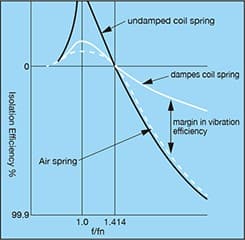
– The natural frequency is the rate of free oscillation per unit time and damping is the characteristic which dissipates energy in a dynamic system.
– The ratio of forcing frequency (the disturbing frequency) to natural frequency (f/fn) is used to determine the isolation efficiency of any isolation systems.
Transmissibility Tr = |1 – (f/fn)2 /1|× 100%
where
f/fn = the ratio of forcing frequency to natural frequency
Graph shows typical plots of isolation efficiency Notice that when f/fn is less than f2=1.414, the curves show that the vibration is magnified, when the forcing frequency is equal to the natural frequency (f/fn=1), maximum magnification occurs. At ratios above 1.414, the curves are in the isolation range. Typically isolators which exhibit the greatest magnification at resonance have the best isolation efficiency (undamped coil spring).
Generally speaking, low amplification at resonance as shown for the plot of a damped coil spring is desirable; however, notice that this is accomplished at the expense of isolation efficiency. Pneumatic isolators with an air spring and damping chamber on the other hand, combines the desirable characteristics of low magnification at resonance and high isolation efficiency as shown the graph.
The equation for determining the natural frequency of a pneumatic isolators is
As seen from equation, the natural frequency of the pneumatic isolator depends on the ratio of the piston area to the volume of the air isolator
Stability of Isolation Platform
Vibration isolation platforms with pneumatic isolators encounters static instability problem, when a high CG payload placed on the platform with a narrow isolator spacing. The platform rocks in the middle of the narrowest spaced isolators at the height of the pneumatic isolator diaphragms. When the CG tilts from one side to the other, the payload placed on the isolation platform tiles, and the weight of the payload leads the payload to tilt even more, causing oscillation.
The stiffer isolators, the better stability of the isolation system, however, as the isolators become stiffer, the natural frequency becomes higher, which degrades vibration isolation performance. Therefore, it is essential to compromise a balance between stability and vibration isolation performances.
Passive Vibration Isolation System
A passive vibration isolation system consists of three components: an isolated mass (payload), a spring (K) and a damper (C) and they work as a harmonic oscillator. The payload and spring stiffness define a natural frequency of the isolation system. While the spring (isolator) reduces floor vibrations from being transmitted to the isolated payload, the damper eliminates the oscillation that is amplified within the isolation system. In most cases, the passive isolation systems employ a pneumatic spring due tos low resonant phenomenon in the low frequency range, a longer stilling time, and lack of controllability.
Active Vibration Isolation Systems
An active vibration isolation system is consisting of feedback and feed forward control systems with integrated sensors and actuators to isolate the most sensitive equipment from the extremely low frequency vibration which the passive isolation systems amplify vibrations at resonant frequencies. The extremely sensitive sensors detect incoming vibrations in alls xi degrees of freedom and a digital controller processes the measured vibration data received from the sensors into the digital signals. Then, the controllers sends the signals to the acutators and the actuators cancel the vibrations by generating equal and opposite force.
Types of Vibration Isolation Systems
Structure of Flat Benches
- Optical Tops consist of ferro-magnetic stainless steel (SUS430) top skin plates, carbon steel bottom skin plates (SPHC), plated steel honeycomb (0.25mm foil, 3.2cm2cell size) sandwiched between two plates and side steel panels, all bonded with high strength adhesive.
- High-damping optical tops apply Broadband Damping technologies and have excellent dynamic stiffness.
- Honeycomb cores (cell size 3.2cm2) made of 0.25mm thick plated steels give maximized stiffness, extensive contact surface with two plates for high rigidity.
- Top skins are precisely grinded to minimize surface curves, pressure bonded to achieve excellent top flatness, lightly sanded with a circular pattern to remove burrs and non-reflecting & non-glare finished.
- Since all mounting holes on top plates are lead-screw tapped instead of using inserts, deformation or looseness of holes does not occur. The M6(1/4-20) tapped holes are for mounting optical components, arranged in a regular interval 25mm (1”).
- Honeycomb cores, top/bottom plates and side walls are rigidly bonded with specially formulated high strength adhesive which allows no elastic bending and hysteresis. Since all parts are made of structural steels having the same coefficient of expansion, deformation such as overall distortion does not occur even in the repeatable temperature changes.
- Cylindrical cups are attached on the bottom of top skins for sealing tapped holes to prevent the inflow of any chemical substances into inside honeycomb cores.
- Upon customers’ requests, special mounting holes and various configurations of optical tops are available.
Table Frame
- Pneumatic Vibration Isolator
Pneumatic vibration isolation supports provide an effective vibration isolation performance both in vertical and horizontal direction in regular laboratories of 10Hz – 60Hz. Compressed air supply systems are required.
- Damping
Pneumatic vibration isolation supports have damping orifices quickly decreasing and settling the movement of optical tops affected by external force or weight transfer.
- Auto Leveling System
– Pneumatic vibration isolation supports are equipped with three auto leveling valves adjusting the inside pressure of the air spring chambers automatically. This is to maintain the height and level of table tops even under eccentric load.
– Pneumatic vibration isolation supports come with casters and levelers for easy movement and installation.
